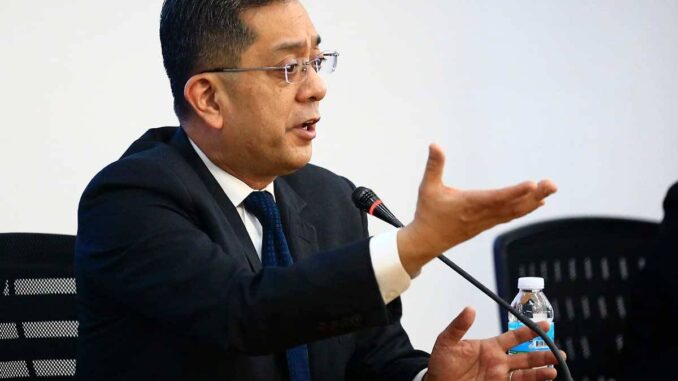
THE Commission on Elections (Comelec) said it now has 85,944 automated counting machines — or 78.13 percent of the total 110,000 that it expects to receive from its supplier, Miru Systems, for use in the 2025 midterm elections.
Comelec Chairman George Garcia gave this update during a media briefing Wednesday at the Comelec warehouse in Biñan, Laguna.
The remaining ACMs are being held by the Bureau of Customs pending clearance and will be delivered soon.
Comelec Chairman George Garcia. PHOTO: MIKE ALQUINTO
Meanwhile, 43,136 of the 85,944 ACMs have already undergone the hardware acceptance tests (HAT), a crucial step in ensuring that the machines meet the technical specifications required for election day. Garcia emphasized the importance of the HATs, as they validate the functionality of each machine, confirming that the devices are working properly before they are deployed for field use.
Garcia also said the Comelec was moving ahead with preparations by conducting field testing of the ACMs and associated systems in select areas across the country. The field testing, scheduled for Saturday, is a key part of the electoral process to ensure the smooth functioning of the entire voting and canvassing process on election day.
The field tests will assess the machines’ ability to correctly count votes, transmit results, and follow the procedures that will be in place in May 2025. The tests will focus on the machines’ integration with transmission systems to ensure that election results can be quickly and accurately transmitted from polling centers to the Comelec’s central servers.
The field testing will take place in a variety of locations chosen for their geographic diversity and signal quality. In some areas with known connectivity issues, alternative methods of transmission, including the use of Starlink satellite internet, will be tested to ensure that results can still be transmitted even in remote or low-signal areas.
In Metro Manila, Taguig, Pateros and Manila will participate in the field tests.
Basco and Ivana in Batanes and Roxas and Quezon in Palawan will also hold field tests,
In the Visayas, Hamtic and San Jose in Antique will participate in the field tests.
In Mindanao, Bongao and Languyan in Tawi-Tawi, Kapalawan and Ligasan in the Special Geographic Area (SGA), Davao City and Malalag will hold field tests.
Field tests are also set for a few overseas locations for overseas Filipino communities.
Garcia said the tests were designed to account for a wide range of geographical conditions, ensuring that any potential issues with transmission or equipment performance can be identified and addressed well in advance of the elections.
During the media briefing, Comelec Information Technology Department Director Jeannie Flororita said that the field tests would follow a series of laboratory tests and end-to-end assessments that have been ongoing. These tests, she said, involve not just the ACMs but the entire election system, including the Fastrac (Full Automation System with Transparency Audit/Count) and the OVCS (Online Voting Counting System).
One of the more critical aspects of field testing will be to test the reliability of the telecommunications infrastructure used for transmitting election results. Garcia said both DITO and Smart Communications SIM cards will be used in the field tests to evaluate their network performance.





Be the first to comment